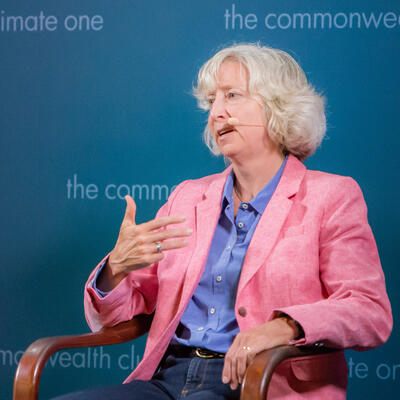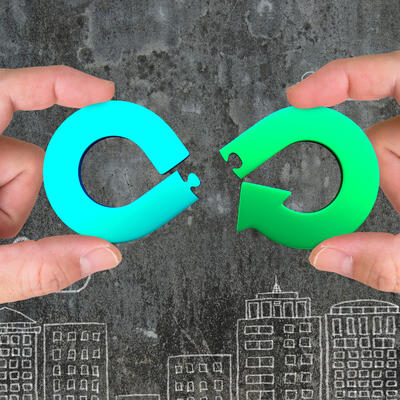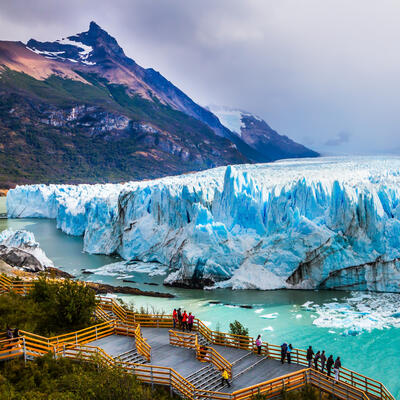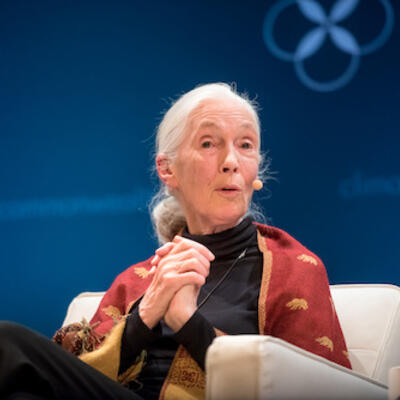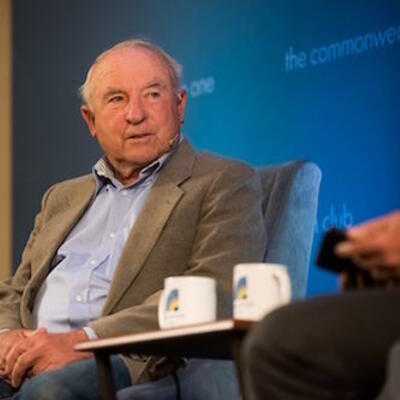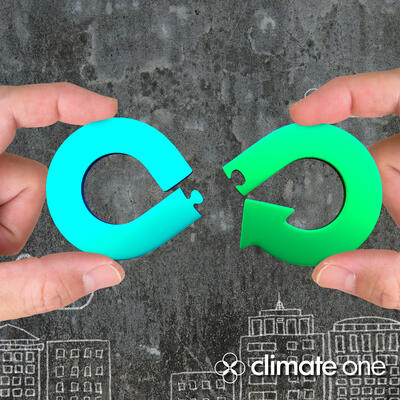
REWIND: Aligning Profits with Planet / The Circular Economy
Guests

Gretchen Daily
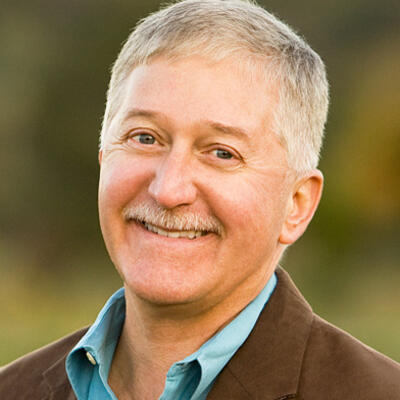
Adam Davis

Barbara Grady
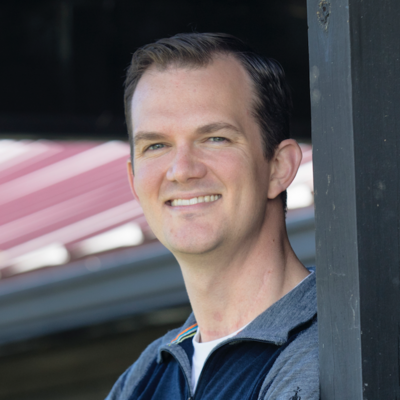
John Lanier

Beth Rattner

Peter Templeton
Summary
Can trees and businesses get along? Business leaders know that consumers are concerned about the environmental footprint of the products they buy. Does that lead to greenwashing or meaningful improvements?
“There are many legitimate leaders out there deeply concerned at a personal level,” says Gretchen Daily, Professor of Environmental Science at Stanford. “And also recognizing their responsibility as leaders in this corporate enterprise that really governs the planet and trying to change it.”
“You can outcompete through environmental performance,” says Adam Davis, managing partner of Ecosystem Investment Partners. “Because half the story is growth and half the story is efficiency. If you can make more money with less inputs, that's more profit. That's a good thing for business.”
“There’s much more consumer scrutiny of what companies are doing these days,” adds Barbara Grady. ”They realize there is a reputational risk if they do not take care of the environment.” At the time of taping, Grady was a reporter for Greenbiz; she now manages communications at Ceres, a group that presses institutional investors to decarbonize their portfolios.
Like his grandfather Ray Anderson, a pioneer in corporate sustainability, author John Lanier advocates for a mindset in which products are designed and manufactured with a focus on permanence, rather than disposability – the basis of the so-called “circular economy.”
“In this vision for the future we become owners of things…not consumers of them,” Lanier explains. “That’s a big and radical shift.”
“Recycling is not the answer or the solution to advancing the circular economy,” Lanier asserts. “It's an answer, but actually one of the weakest ones. It’s what we should do as a last result before we throw something in a landfill.”
Rethinking our manufacturing methods and energy resources is another key element, says Beth Rattner of the Biomimicry Institute. Innovative companies are “going circular” by transforming how their products are designed, used, and remade into something else. And, says Rattner, the best examples of how that works can be found in nature.
“Imagine if everything we made was functionally indistinguishable from nature,” she suggests. “That's the goal.
“Because when you walk into a forest, that whole forest is working toward a single common good, which is the protection of the forest; that is its survival strategy.”
And as more and more corporations and consumers embrace the concept of a “circular economy,” it may turn out to be ours as well.
“Aligning Profits with the Planet” was recorded in front of a live audience at The Commonwealth Club of San Francisco on July 27, 2017
“Can a Circular Economy Salvage the Climate?” was recorded in front of a live audience at The Commonwealth Club of San Francisco on May 7, 2019
Related Links:
Greenbiz.com
Ray C. Anderson Foundation
Biomimicry Institute
Cradle to Cradle Products Innovation Institute
The Ecology of Commerce: A Declaration of Sustainability (Paul Hawken)
Full Transcript
Greg Dalton: This is Climate One. I’m Greg Dalton.
On today’s program - going green to stay in the green. Business leaders know that consumers are concerned about the environmental footprint of the products they buy. Does that lead to greenwashing or meaningful improvements?
Gretchen Daily: There are many legitimate leaders out there deeply concerned at a personal level, and also recognizing their responsibility as leaders in this corporate enterprise that really governs the planet and trying to change it. [:15]
Greg Dalton: Innovative companies are “going circular” by transforming how their products are designed, used, and remade into something else. This “circular economy” is inspired by nature.
Beth Rattner: When you walk into a forest, that whole forest is working toward a single common good, which is the protection of the forest; that is its survival strategy. [:12]
Greg Dalton: Aligning profits with the planet and the circular economy. Up next on Climate One.
---
Greg Dalton: Can what’s good for the planet also be good for business?
Climate One conversations feature oil companies and environmentalists, Republicans and Democrats, the exciting and the scary aspects of the climate challenge.
On today’s program, we take a look at the ways corporate leaders are changing their thinking and operations to lighten their environmental impact - from far away factories to the boardroom.
Adam Davis: If you can make more money with less inputs, that's more profit. That's a good thing for business.
Greg Dalton: The business stakes are rising as Millennials, who say they care deeply about the environment, flex their market muscle and look for brands aligned with their values.
Barbara Grady: There’s much more consumer scrutiny of what companies are doing these days so they realize there is a reputational risk if they do not take care of the environment.
Greg Dalton:Today, we’ll revisit two discussions about aligning profits with the planet, and the companies that are working to bring full circle the things we make, buy and use. First, three guests who joined us on the Climate One stage in July of 2017. Gretchen Daily is Professor of Environmental Science at Stanford University. Adam Davis is managing partner of Ecosystem Investment Partners, a firm that helps people make money by cleaning up the environment. And Barbara Grady was a senior writer at GreenBiz at the time this program was recorded. Currently, she manages communications at Ceres, a group that presses institutional investors to decarbonize their portfolios.
There’s an age-old mindset that the economy and the environment are at odds - that what's good for the one can’t be good for the other. But is it true? Here’s Gretchen Daily
PROGRAM PART 1
Gretchen Daily: It's definitely true when you look back at the 20th century. We pursued an idea of growth kind of at all costs. It’s not true for the 21st century. We’re opening up in a time when a lot of odds are against us. But where there is incredible innovation and a vision of green growth that allows both improvement in human well-being and all the dimensions that really are meaningful of health, economic prosperity and security. And at the same time a restoration and conservation of the life-support systems – the green – that underpins all of our well-being. And we’re seeing this vision now play out in thousands of what today are basically mostly little experiments but also some really big mega experiments going on that we’ll get into.
Greg Dalton: Adam Davis, still business world and environmentalists are like oil and water. They don't like each other. They're often, particularly in a polarized society. Does it have to be that way or is there anything, do they meet anywhere in the middle?
Adam Davis: I think they do. One of my fondest memories when I was in the recycling business was lobbying with environmental groups for stricter environmental standards. And you might think why would a large company in the solid waste business be in favor of stricter environmental policies. And the answer was because it was good for our business. You can outcompete through environmental performance. In this case, stricter landfill standards which were good for the environment also created competitive advantage for the businesses that would adhere to those policies. That’s one example. There are a lot of others based on Gretchen's work about the financial value of natural systems.
Greg Dalton: Barbara Grady, GreenBiz site is all about sustainable business, et cetera. You know, is this kind of on the fringe of corporate America or is it kind of working its way into the core of corporate America – this idea that the economics and environment can be friends and allies?
Barbara Grady: I think it’s slowly working its way into the core of business because they’re realizing the value of sustaining the things that they need. Be it water, land, agricultural goods that will not ruin the land for future growing of crops. And there are also their consumers and their customers. There’s much more consumer scrutiny of what companies are doing these days so they realize there is a reputational risk if they do not take care of the environment.
Adam Davis: If I might, you know, Gretchen was talking about the difference between the 20th century and the 21st. And I think some of that is the difference between environmentalism and sustainability. So environmentalism at its core is against something. So all the environmental laws in the United States, the Clean Water Act, the Clean Air Act, Endangered Species Act, Superfund, all these laws, as necessary as they are, were fundamentally saying, no, stop it, don't move, this is a limit. And those laws were critical when pollution was out-of-control. The question now is after we've internalized a lot of those problems into normal business practice and compliance is commonplace, how do you move from a place of simply trying to stop bad things and asking instead how would you make products and services in a sustainable manner? It's a totally different kind of question and a much more challenging one.
Greg Dalton: And Adam Davis, do you support the deregulation that the Trump administration is pursuing now which is get rid all of those stop limits. Take off the handcuffs, do you support that?
Adam Davis: Not at all. Matter of fact, just like a referee on a football field or an umpire in a baseball game is critical to the game, you've got to have rules and you’ve got to have clarity. I think most of the large businesses in America, the majority, would tell you that they don't want the environmental laws to be all taken away. What they want is fairness and efficiency in following the law. They don't like to play let's make a deal they don’t like confusing, complicated regulations. But clear regulations that provide limits that tell you what you’re allowed to do and what you’re not allowed to do are good for business.
Greg Dalton: Barbara Grady is that true you tend to cover the greener companies. But you also cover some pretty dirty ones, is that true?
Barbara Grady: Yeah. Well, I think it’s true. And there’s another aspect of it I think in the past, I don’t know how long Gretchen would know, but supply chains are much more in focus than they were in the past. And companies are running into the limits of water and the limits of a whole range of resources that they’ve depended on in far away places. And when there's droughts and there is water contamination and in various places that they have little control over because it's a far-flung operation or because the supply chain is three steps removed from their direct operations. They want some form of order and regulation to know that what they can rely on.
Greg Dalton: There's lots of certifications out there but it’s pretty perplexing because there are so many labels out there and greenwashing is so prevalent. How is the consumer supposed to know, I mean, and you could spend, you know, a lot of time just thinking about your tea and then you got your cereal and you got your muffin and your bread and like by time, you know, you spent hours figuring out your breakfast. So how is that information –
Gretchen Daily: I agree. It’s super confusing. Now I just was living in Sweden for a couple years where they've taken this to a fine art. But I think we’re on a cusp of a revolution there and that some of these big companies, Unilever is one that stands out with Paul Polman having as CEO declared that they're going to eliminate deforestation from the supply chain. You know, that is an opportunity for us citizens to get on the ball and make sure that those commitments are actually lived up to. And that means enabling this tracing of products. It also means, you know, the group I'm heavily involved in the Natural Capital Project developing software tools that are easy to use that let you make sense of some of that and boil it down to much simpler kind of comparable metrics as to the impacts on say the climate system or on water quality or on biodiversity of different products.
And we've actually worked on plastics in packaging, you know, should you have bioplastics that come from different bio feedstocks like corn or others, or should we have petroleum-based plastics. And you could go in circles thinking about the full life cycle assessment and stuff. But I think we’re going a lot further today with the technology out there for tracing and for really understanding what the impacts are of different choices. So I'd say it's frustrating now, but I think we got to keep pushing and we’re gonna get the clarity when we need.
Greg Dalton: Walmart's been a leader in the sustainability area particularly since 2005, when their CEO gave a famous talk saying they wanted to get on board they’ve stepped out on climate change. Gretchen Daily, is that story as true, is there any greenwashing going on there?
Gretchen Daily: I'd say that there are two hands that work here across the world and kind of maybe even in all of our own lives. On the one hand, we have emerged out of the 20th century with a paradigm of thinking about what the environment is and means to us and nature and ways of extracting value from it that is just completely unsustainable. And we’re actually, as I'm sure all the listeners here know well so we won't harp on it, but we’re at a real crisis moment. And then you see companies coming out on the other hand saying we’re gonna address the crisis, we’re gonna take this on. And I feel it's just complex. We can't say, oh it's all good or all bad. We have to be really open eyed and kind of skeptical and realistic. At the same time we really have to get behind and support the pioneers that are driving the change and our thinking and our culture and then with that opening up the possibility of new ways of doing things.
So I feel that these leading companies are pioneering new ways of doing things. If no one judges them, who knows if they’ll really go anywhere with that, it's easy to slip back into the old easier profits and stuff. But there is huge incentive - and I'm sure Adam and Barb, you know, can elaborate more -- to change now. And there are many legitimate leaders out there deeply concerned at a personal level, and also recognizing their responsibility as leaders in this corporate enterprise that really governs the planet and trying to change it.
Greg Dalton: Barbara Grady, Walmart could have a lot of impact given their scale. They reduce packaging on something they can really have an impact, but yet underneath they want more sales, more consumption.
Barbara Grady: I just want to say if I can back up a little bit. I think Walmart didn't go there by themselves they were very involved with the Environmental Defense Fund in figuring out the sustainability steps. And this is happening with a number of environmental NGOs collaborating with companies to kind of push them to move them beyond their comfort level. And my understanding of that situation is the Environmental Defense went to kind of challenge them, take a lead on this, look what's happening, and kind of pushed them. And they went along with it and they have become a leader and their customers and suppliers are following.
Greg Dalton: Adam Davis.
Adam Davis: I would just say that Walmart wouldn't deny that they have enormous impacts neither would Unilever nor would 3M or Ford or anybody who has a major business. But that doesn't mean they can't also be leaders in solving problems. Matter of fact, I would argue that if you want to solve a problem you gotta go where the problem is. And the problem isn't just in Ben & Jerry's ice cream and Tom's toothpaste. It's in transportation and mining and energy, making buildings. And the real stuff of our economy, where most of us work and where all of us consume products from. So if we’re gonna make progress in this, we obviously have to engage with all these folks.
Greg Dalton: But what underlies all of this is more, is growth. And the incentives for the CEOs of those companies is compounded quarterly growth – more, more, which means sucking more stuff out of the ground, selling more stuff to us. And it's that part that none of these companies are kind of scratching the surface, but that driver, Adam Davis, that ultimately where does that head?
Adam Davis: So that’s only half the story, right. Because half the story is growth and half the story is efficiency. If you can make more money with less inputs, that's more profit. That's a good thing for business.
Greg Dalton: And some people would say the technology industry is doing that because it’s more virtual, it's not as kind of bricks and mortar tangible things.
Adam Davis: Well they end up promoting the production of and the consumption of goods and services. So the information folks are not off the hook in my point of view at all. But what I would say is that if you look at where things come from and where they go, right. Everything starts with primary resource extraction. So mining, agriculture, oil and timber, right. That's where everything comes from. Everything in this room, everything we’re wearing it all comes from those four places. And at the end of the system, you have landfills. And in between you have this enormous system of manufacturing, transportation, distribution, retailing consumption and so on. Everyone in the middle has an incentive to be efficient, but the people at the beginning and the end get paid by the ton. So it's about recognizing the fundamental incentives that people respond to as they make their business decisions and working through policy to make the incentives line up so that you can outcompete through environmental performance. And when you get the policy right, the more good you do, the more money you make.
Greg Dalton: If you’re just joining us, we’re talking about nature and capitalism at Climate One. I'm Greg Dalton. My guests are Stanford professor Gretchen Daily, you just heard from investor Adam Davis and we have reporter Barbara Grady.
Let’s talk about the population, it’s something that environmentalists don't like to talk about. Gretchen Daily, you were mentored by Paul Ehrlich who wrote The Population Bomb I think 50 years ago this year or next year ago.
Gretchen Daily: Sixty-eight I think.
Greg Dalton: Okay. So a lot of people criticize him for saying, ah, the boom you forecasted didn’t happen, it might've been in just a matter of time. But we could talk about all these things, but it feels like rearranging the deck chairs on the Titanic if we’re really going to, Al Gore said to me the other day, 11 billion people.
Gretchen Daily: Yeah, I think everybody sees that Earth, you know, we know what it looks like now from outer space. It's that little blue ball out there and it's not gonna hold an infinite number of people. And the question is how do we turn that understanding into, you know, compassionate, effective kinds of incentives for a sustainable path. And it requires understanding, you know, why people have the number of kids that they do and there are a lot of really good reasons to have large families. And until we address those reasons which include things like having labor to help run the farm, having security in one's old age or ill health and, you know, just maybe not having other options for controlling one's fertility or one's livelihood. So I feel there are compassionate PAVs that will need more nurturing to enable people.
Right now, many, many women are having more children than they would choose to have. And we want all children to be wanted children who can be supported in a healthy life and have the possibility of achieving their aspirations with dignity and all of that and then so much of the world that's just not the case. So when you look back at The Population Bomb, I think some of it was written in a scary style that, you know, is dated in a sense now, but it's the way people spoke and wrote back in those days. And I feel, you know, much of what was visualized in there has come to pass. Unfortunately, hundreds of millions of people have died of hunger and hunger related disease over the years and they die silently and invisibly. So we think, oh it's not happening, but it is happening.
And we now have, you know, a couple billion people at least living in lifestyles that we would never voluntarily trade for. And unless we had opened our eyes as a society and as individuals and understand the situation more and that the role that population plays in intensifying our challenges, you know, we’re not gonna really get to the dream that Adam’s sort of laying out now that, you know, the future it's about sustainability and that balance between, you know, people and what this big beautiful ball can possibly support at a level at which we’d all want to live in the future.
Greg Dalton: Adam Davis, you said that U.S. population probably going to 400 million. That means there’s gonna be a lot more natural impacts, roads, people footprints gonna get bigger. Is that, you know, how are we gonna handle that?
Adam Davis: Well, Paul Ehrlich said in The Population Bomb that impact equals population times affluence times technology. And while I don't think we’re gonna get out of this scot-free there will be major impacts on communities around the world as we expand our population to 11 billion. But if we have a hope, it's being innovative and efficient in our use of resources and our allocation of resources. That's our hope. The population will grow. That is going to happen. And so then the question is how can you create abundance and affluence with a technology and an approach to living that is way more efficient and effective, that addresses impacts scientifically and offsets them. And that creates real incentives for people to do the right thing up and down the system.
So just in the United States as the population is going from 300 million to 400 million we’re building lots of new roads and lots of new energy infrastructure and lots of new, you know, schools and housing and commercial developments. All that stuff is happening. One of the things that we've done since 1972 is we’ve required an offset for impacts to our waters, the waters of the United States. So an impact to a wetland or a stream has to be offset acre for acre with restoration in the same watershed. And I think a lot of people would be surprised to learn that a little company like ours has raised $500 million just in the past five years exclusively for ecological restoration. It doesn't address the giant issue of population worldwide I realize that. But it's a great example of how private capital is being harnessed through scientifically verifiable restoration to address the impacts of development. So that as development occurs you've got an offset that actually meaningfully makes up for the impact. What happens then is that the road or the school where the commercial development is more ethical than it would be otherwise, right, it still happens. But there's a meaningful connection between the development and the economy and the nature that supports it.
---
Greg Dalton: You’re listening to a Climate One conversation about aligning the economy and the environment. Coming up, seeing dollar signs everywhere in nature.
Leila Salazar-Lopez: Do we have to put a price on trees, do we have to put a price on rivers, do we have to put a price on forests in order to protect them? We don't believe so.
Greg Dalton: That’s up next, when Climate One continues.
---
Greg Dalton: This is Climate One. I’m Greg Dalton, and we’re talking about nature and capitalism. My guests are Gretchen Daily of Stanford University, Adam Davis of Ecosystem Investment Partners, and Barbara Grady, who was a senior writer at GreenBiz when this program was recorded.
Climate disruption is heightening concern about the stability of water supplies as we see alternating severe droughts and floods. Is water a right or a commodity? Gretchen Daily weighs in.
PROGRAM PART 2
Gretchen Daily: You know everybody should have water. Let's face it, right. We can't live without water. If we’re a leader in a society it should be our responsibility to ensure that people have access, have sort of the right to water. But at the same time to do so means getting really strategic and practical. Now that every scrap of land and every drop of water with our burgeoning population, you know, it's a zero-sum game. And assigning value to something I don't think reduces its value necessarily. So for example if we’re trying to assign value to water to limit overuse of it, it’s in a way it’s like charging people at a buffet. Rather than having an all you can eat buffet where kids and everybody I know go along getting all the desserts, you know, charge a price. Assign some table manners. That's what we’re talking about in most of this. So it's not kind of one or the other. I think we need to both state our values, but then recognize who we are as a species and develop policies and kind of incentives that, rules of the game that, you know, make us play fairly with one another and achieve an outcome that we all aspire to.
Greg Dalton: Not everyone agrees. We’ve been talking a lot about sort of the assigning of economic value, bringing capitalism to areas perhaps indigenous cultures, et cetera and bringing markets. And a lot of times as outside people, not everyone agrees with the commercialization of the environment. Amazon Watch Executive Director Leila Salazar-Lopez is one of them. Let’s listen.
[Start clip]
Leila Salazar-Lopez: Green capitalism is not going to save the Amazon. One of our big concerns right now and for many years has been the commodification of forest or the commodification of trees or the commodification of nature. Do we have to put a price on trees. Do we have to put a price on rivers, do we have to put a price on forests in order to protect them. We don't believe so. We believe that if indigenous peoples and traditional peoples have the rights and territories therefore they will protect them. And the solutions don't always come from the dominant society.
[End clip]
Greg Dalton: That was Leila Salazar-Lopez, Executive Director of Amazon Watch. Gretchen Daily, I’d like to get your response to that.
Gretchen Daily: Yeah. At one level I agree with her completely. And feel that robbing indigenous peoples of their homes of hundreds to thousands of years and denying their stewardship of those places is utterly wrong and kind of against all of our interests. At the same time, when you look at the threats to the Amazon, one of the threats is climate change and also sort of deforestation by people other than indigenous people. And these threats really need to be addressed head-on. We’re in a capitalist system that none of us invented but we've inherited it. And in a way we've gotta confront it. And so in that arena I feel that the countries, for example, most responsible for driving climate change need to live up to that responsibility in a way and address it, and help protect the Amazon which is this crucial part of the whole planet’s life-support system. So if the Amazon disappears it’s going to have massive impacts absolutely everywhere. So at that level, indigenous people alone are not gonna be able to save the Amazon. So there’s a complexity here, as in most things. And I think a dual approach of securing indigenous peoples’ rights to lands that they have stewarded really well over millennia and their culture. And then at the same time developing incentives to achieve the sustainable outcome we want on the part of all the other players influencing the Amazon is crucial. And that involves confronting and using our capitalist system.
Greg Dalton: Adam Davis.
Adam Davis: So the fundamental question that was raised there is about whether it's right or wrong to commodify nature. If you look at American environmental policy we actually started with command-and-control regulation that basically said stop the pollution, stop the damage, right, without regard to whether nature was a commodity or not. It basically said here's a limit on water pollution. Here's a limit on air pollution. There's no net loss of wetlands here are limits for toxics and so on, right. It wasn't about commodification it was about trying to stop bad things. The problem is that there is no particular limit that's the right limit, right. You can always --whatever number you pick is a compromise. And let's say it's 10 parts per million. That's the answer that you come up with. That means you're just fine that 9 parts per million, everything’s fine. But at 11 parts per million you’re a criminal. And that can't be right because if 11 makes you a criminal, then it’s not just fine at nine and so on. The challenge then is to go beyond that and to actually reward behaviors on land that protect the waters of the United States. Protect the species and their habitats and so on. To say that we shouldn't commodify nature we shouldn’t put a price on it I think is fundamentally misguided in the United States at least because we've already put a number on it. That's the problem, is that any landowner, any piece of land in the U.S. has already been appraised. If you ask a landowner how much their trees are worth they know how much the trees are worth.
Greg Dalton: Dead, but not alive.
Adam Davis: They only worth money if you cut them down. So to say you shouldn't commodify nature is to say we shouldn't have a price on the tree if you cut it down. We shouldn’t have a price on the coal if you dig it up and so on. But there is a price on all those things. It's real estate and natural resources. And it commands the economy. And so in order to combat that, we need a countervailing economic force which is the value of nature, not by building on it or taking from it, but paying people for what it does in terms of clean water, resilient living systems and a stable climate. We gotta pay people for those things.
TRANSITION:
Greg Dalton: We’ve been talking about aligning profits with the planet, with Adam Davis, Managing Partner of Ecosystem Investment Partners, Barbara Grady, who was a Senior Writer at GreenBiz when this program was recorded in 2017, and Gretchen Daily, Professor of Environmental Science at Stanford University,. This is Climate One, and I’m Greg Dalton.
Greg Dalton: Can a circular economy salvage the planet? To help answer that question, we welcomed three experts to Climate One back in June of 2019. Beth Rattner is executive director of the Biomimicry Institute. Peter Templeton is President and CEO of Cradle to Cradle Products Innovation Institute. And John Lanier is director of the Ray C. Anderson Foundation, named for his grandfather, who founded the billion-dollar carpet company Interface in the early seventies. John Lanier starts us off with the story of his grandfather’s conversion from industrial magnate to a pioneer of the corporate sustainability movement. His journey began with a question.
PROGRAM PART 3
John Lanier: What is Interface doing for the environment? That question then made Ray open to reading a book. And the book was The Ecology of Commerce written by Paul Hawken that charged business and industry as the sector responsible for the greatest amount of environmental degradation, but the only sector large enough well enough organized and capitalized to fundamentally solve the environmental challenges that we have.
Reading that book was an emotional experience for Ray. That was what he called his spear in the chest moment. When he realized he was this plunderer of the earth, and from that day forward, he was committed to making his business, Interface, a publicly traded industrial manufacturer, as environmentally sustainable as possible so that he wouldn't have to be that plunderer, that legal thief that he referred to himself as.
He was a remarkable individual. He could talk about the bottom line and the price-to-earnings ratio of the company and everything that Wall Street wanted to hear. But when it came down to it, he was motivated in this quest up mount sustainability with the people of Interface out of a deep sense of love. And that love was for the people of Interface, and importantly that love was for the generations of people who have yet to walk planet Earth. Because he understood what was at stake for real people when it comes to environmental work.
Greg Dalton: Peter Templeton, tell us, you know, we hear circular economy, what is that? Some people maybe have trouble defining it. Help us understand what is the circular economy?
Peter Templeton: The circular economy challenges us to look beyond the traditional take, make, waste perch of the linear economy that exist today to overcome some of the challenges facing us as a society by looking at where the opportunities exist for us to recover those materials to retain their value and repurpose and regenerate them into new products that can continuing perpetual cycles of use.
We’re looking to up cycle to find greater value in this products and materials through each use.
Greg Dalton: Beth Rattner, lot of people probably thinking about recycling, you know, okay, but there’s a bit of a recycling problem right now. Now that China has stopped accepting, you know, China doesn't want to be the dumping ground they want to kind of move up the value chain. So what is that doing to recycling because it’s kind of got a black eye these days.
Beth Rattner: It’s a really important question. And I'm gonna pivot a little bit on it only because there’s -- so after the management consulting and before Biomimicry, I was with Cradle to Cradle for a number of years. And there's this fundamental recognition that we are making things out of the wrong other things, right. If you look at how nature makes everything us included, it's mostly carbon, it’s hydrogen, it’s oxygen, it’s nitrogen. That's the most abundant, you know, set of elements that exist. At the very, very bottom of that would be the trace elements the aluminums, right.
So we can talk really frankly proudly about our aluminum recycling but the truth is we should be looking at the more abundant set of elements. And that is when we start talking about pulling carbon out of the air taking it from source emitters pulling methane off of farms and creating new kinds of stuff new kinds of plastic the way that New Light Technologies is doing with air carbon or Blue Planet is doing with concrete. That's the recycling story we should be telling
Greg Dalton: So we should start to back up and start using what are we making stuff out of. Making out of the abundant things, not the scarce things and that would sounds like that would be cheaper if you’re using something that’s abundant rather scarce, right.
Beth Rattner: It solves a couple problems, yeah, it solves a couple problems. Go ahead John.
Greg Dalton: John Lanier.
John Lanier: I want to highlight something about the concept of recycling. It is considered this remarkable green practice and it is. We should celebrate how far we've come in that space and mourn the fact that we've lost the ability to recycle plastics in China. But when you think about the circular economy, recycling is not the answer or the solution to advancing the circular economy. It's an answer, but actually one of the weakest ones. And I would point to the work of the Ellen MacArthur Foundation some of their thought leadership in this space and the graphic that they use to depict all of the ways in which a circular economy would work. They show multiple loops. They're not the only ones who have shown this. But the number of loops are important because the tighter ones things like reusing an item that’s a circular economy practice that keeps things at the highest value.
Greg Dalton: The cycle is actually at the end. Reduce, reuse, recycle.
John Lanier: It’s the last one it’s what we should do as a last result before we throw something in a landfill. So we have to be championing the more impactful circular economy solutions.
Greg Dalton: And so Peter Templeton, what are companies doing to sort of step up and use better materials from the beginning that maybe don't need to be recycled. So take us back further upstream.
Peter Templeton: Well, I want to add to this thread here and say that the starting point for us is always going to be safe materials. We want to be looking at safe and circular. So we are looking at the material health of those components to make sure that when we’re perpetuating those materials not only are they good for the health of the people and our planet, but they also have the maximum options for use in the future because we know that they're not going to cause unintended harm or consequences. So that’s the starting point for us.
And what is really beautiful is seeing so many organizations that are rising to that occasion seeing the opportunity that exists around this when they do take those steps to be able to continue to create value from their own products by reclaiming those products through cycles of use. And they have many different examples of that we see in products and services these days. When we look at just challenging our concepts of how things are delivered like lighting with Philips lighting Signify now moving into a model where they’ll be able to provide lighting as a service to organizations. So they take on the responsibility for those materials through their lifecycle. They maintain those lightbulbs those fixtures and maintain a cycle through which they can reuse those and repurpose them beyond their immediate use. But the client benefits from that from lower upfront costs and of course having the continued use of light throughout for its purpose.
Greg Dalton: So, lighting as a service you don't buy your bulbs you rent them. Someone comes to fix them they take them back. I think Interface tried that with the carpet early on didn’t work so but they were ahead of the game.
John Lanier: They were. They call it the Evergreen lease and that was the hope, could Interface always own the carpet that they make and just lease it to people. Put it in their facilities and maintain it, clean it, take it back at the end of its useful life and repurpose it then recycle it into new carpet, keeping it in a closed loop manufacturing system. There are challenges candidly and Interface isn’t able to utilize the Evergreen lease, at least not now, I think they'd jump at the chance to start it back up. But some of those challenges are how do you do the accounting for something like this.What are the depreciation schedules on a leased product compared to an owned product. Created challenges that weren't all able to be solved. It just shows we have more work to do.
Greg Dalton: So let’s get real specific about materials. Beth Rattner, walk us through a potato chip bag and all the materials used in there.
Beth Rattner: Well, I have to credit Janine Benyus.Janine has this beautiful quote which is, imagine if everything we made was functionally indistinguishable from nature. That's the goal because when you walk into a forest that whole forest is working toward a single common good which is the protection of the forest that its survival strategy. It's not going to take you out in the hopes that I’m gonna win only to find out that I’m gonna need you later, right.
And so the same is true for the potato chip bag. We’ve got into this place where we have to have where we use a lot of different chemistry all because want to sell this particular bag of potato chips for this single use. Whereas, and it’s gonna have one layer for protecting the oil, another for keeping air out, another one for the packaging you know, the bright colors that you pick it off the shelf to begin with. But that’s not how nature designs. It uses a very small, limited palette, but it uses structure to create very different functions.
So once you have these different structures in place. Now all of a sudden you can achieve amazing new capabilities. You can have bumps that shed water. You can have ridges that actually channel specific bacteria or repel that bacteria. We can do things with structural color. We don't have to use pigments and dyes. We don't have to make our rivers the colors that they are in Asia by dumping 450,000 gallons of wastewater in there every day because we want to look good. It's all about rethinking that pallet of materials and structure.
---
Greg Dalton: You’re listening to a Climate One conversation about refashioning our economy to use up less of the planet’s resources. Coming up, breaking the cycle of produce, package, purchase and trash.
John Lanier: So in this vision for the future we become owners of things…not consumers of them. That’s a big and radical shift.
Greg Dalton: That’s up next, when Climate One continues.
---
Greg Dalton: This is Climate One. I’m Greg Dalton. Climate One records many of our conversations with a live audience at our modern and green new home on the waterfront in San Francisco. We have suspended public events through April and possibly beyond. When we resume public events and you are in town come check us out. Our programs are open to the public and listed on climateone.org.
We’re talking about creating a circular economy to salvage the climate. My guests are Peter Templeton of Cradle to Cradle, John Lanier of the Ray C. Anderson Foundation, and Beth Rattner of the Biomimicry Institute.
We’ve been hearing a lot lately about the extinction crisis, as more and more species fight to survive in a changing climate. It’s a disaster for so many reasons. But as Beth Rattner explains, it could also mean the loss of some unsung biological heroes.
PROGRAM PART 4
Beth Rattner: There is a little organism called the springtail that is probably not in danger of currently going extinct but if you saw it you would absolutely want to extinguish it. It’s a little blue organism it’s often found in marine environments and when you type in springtail into Google, you will see exterminator options coming up.
This little guy holds the key to about a $23 billion market in fashion about a $54 billion market in auto and probably $110 billion market in semiconductors because it knows how to repel oils and water and everything else. It's very uncommon to be able to find oleophobic surfaces in nature, but it has this very specific sort of mushroom headed structure. And so when the oil or the water it doesn't actually, it's got tiny hairs in addition, but it also because of that mushroom structure it’s not going to wet the core surface.
That molecule of oil that molecule of water isn’t wetting the surface. Now all of a sudden you have a massive water and oil repellent solution. So before we go extinguishing things before we go calling the exterminator or worse before our climate takes out some of our best teachers, we should be thinking ahead.
Greg Dalton: There’s also another example that you talk about Beth, which is there's a professor at Stanford that’s shaping wind farms using lessons from fish. A good example of biomimicry.
Beth Rattner: Yeah, vortices. Project Drawdown, which is a phenomenal resource talks about moving wind from 4% to 22% by 2050, right. It’s gonna cost about $1.2 trillion to do that. That's a lot of capital. But what if we could actually do this in a biomimetic way. So the way that schools of fish work the very first fish is out there and he swims and little tail is going. And then the guy behind him doesn’t have to swim quite so hard. So that vortices that are cast means that you have a much higher rate of efficiency of energy.
So John Dabiri out of Stanford took his vertical wind turbines and grouped them like the school of fish. He was able to get 5 to 10X the output of energy just because when that first wind turbine started to turn, so did the guy behind it. So we can spend $1.2 trillion and we should on new wind farms, but we can maybe spend less have fewer of them which has of course a land impact anyway all because we’re looking to biomimetic models.
Greg Dalton: Peter, let's talk about some of the big drivers behind this. Walmart’s done a lot on packaging are they still doing that, you know, they can do a lot of things at scale. If Walmart cracks the whip companies in the supply chain have to fall in line, is that still a big driver or they kind of plateau out all of the savings on packaging and other things they can get?
Peter Templeton: No, I don't think we’re anywhere near plateauing on the savings that’s possible and certainly the need for it. And I think this is cutting across again retailers and entire consumer markets at this point are looking where those opportunities exist both in terms of opportunities to optimize the products to consumers as well as the packaging associated with them. And then of course larger systems that deliver them. We’re looking at the suppliers themselves, distribution and the opportunities to reclaim some of those materials. And again, this is another area what we’re seeing a lot of innovators that are stepping forward to be able to present different cases of their own success.
We have, you know, folks obviously that you've talked to before, like Method where they brought together consumer products for their personal care items. Where they've looked at opportunities for them to reclaim plastics from beaches in Hawaii, bring them into their process for delivering better packaging for their products which are also healthier and safer products as well.
But we see that also being followed by other groups like L'Oreal and more mainstream groups that we’re really excited to see them looking not only at how their products that have earned Cradle to Cradle certification are delivered but also the packaging behind them. And they’re now engaging in broader initiatives around the packaging for those materials with Nestle Water with Pepsi-Cola and others to look at how they actually reclaim those materials and make better packaging for their collective set of consumer products that they deliver.
Greg Dalton: Beth Rattner, where is that going in terms of plastic bottles if they’re not gonna be up cycled they’re not gonna be made into clothing. A lot of tension these days plastics in the ocean, we’re just drowning in plastic bottles.
Beth Rattner: We are drowning in plastic bottles and more plastic than fish, right, by 2050 is the current number that's being talked about. I have so many different ways I wanna answer that question and I’m not sure which way to go. So part of me wants to say -- the thing about how nature operates is number one is all spent on avoidance. We shouldn’t have gotten ourselves into the problem to begin with and like the structural color example it’s a really good way. Well, let's not think about how we’re gonna clean up the rivers let's talk about how we’re not gonna keep polluting the rivers to begin with.
We have to think about this as we are all in this together. Employer responsibility for pollutants would be a phenomenal thing but right now we’re all experiencing the impacts of it anyway. So why don’t we design solutions where we can all help the problem. And so I feel like that’s the biggest answer for Biomimicry out of the question the way that you're asking for me is how are we all gonna play a role in this cooperation. We all contributed to it, so what's the cooperation model that we should be following?
Greg Dalton: And John Lanier, I think Interface may have a, what, carbon negative carpet. So the idea of carbon right now is kind of this waste product that’s put out there for no charge. So talk about rethinking carbon as an input that's actually valued in industrial production.
John Lanier: Sure, yeah. Interface, and this was true to Ray Anderson's original vision, never just wanted to do no harm which is perhaps the best definition of sustainable that you can have. They always envisioned more: becoming a regenerative enterprise. What would it look like for a company just because it operated just because it did what it did. What if that made the world more just, more environmentally safe? Could Interface help reverse global warming through its operations?
Well, yes, they can transform their enterprise to do that and perhaps one of the most important ways that they can do so is to look at what they produce and ask the question. Can we sequester carbon in what we make? Can enough bio base material be added to Interface carpets where there's no loss on performance but the carpet actually has a negative carbon footprint. And the R&D team came back and said, yeah, we got your answer. The company is now working to commercialize that scale it and they've already made a commitment that all products sold today around the world has no carbon footprint because of offsets.
Greg Dalton: We’re talking about circular economy at Climate One with John Lanier, Beth Rattner and Peter Templeton. Beth Rattner, you talk in one of your videos about humility and how confronting nature requires some humility. So tell us what you mean by that. When you look at humility, look at nature how it requires us to be humble.
Beth Rattner: There is so much chemistry that happens in nature. There is so much intense sophisticated design that again back to that springtail that you would want to squish or the scarab beetle, which is, have you ever seen the ones that are silver or gold or brightly colored green, almost metallic looking, you know, that’s five microns thick, right. It's super, super thin. And again the average person even my adorable nieces are scared of bugs they’re scared of spiders. But we've been able to turn that around for them because we talk about all that they can accomplish. The tensile strength of the spiderweb itself like I said, the vibrant colors that are produced on the beetle from those tiny, tiny layers, by the way five microns is like 1/10 of your human hair. We’re talking about a very thin layer that’s able to just generate immensely gorgeous colors. How can you not be humbled by that how can you not look at how nature makes something so beautiful and so small and then what we do when we're trying to make color ourselves, or structures ourselves.
Greg Dalton: Peter Templeton, what’s the world look like if Cradle to Cradle, what’s the vision of, you know, what’s manufacturing consumption look like and should we really address the underlying driver of consumption itself rather than trying just make better products.
Peter Templeton: Absolutely. They’re both part of the equation. I mean in our philosophy, Cradle to Cradle, and circular economy we’re looking to make sure that we’re taking very pragmatic view. We are working towards or moving towards a planet of 10 billion people plus and we have to look at what is going to be required to support and sustain quality of life within the next 10 years or so. Our middle class is now going to double in size to over 5 billion people. So we want to make sure that we’re not looking at this from the perspective of scarcity we’re looking at a perspective of abundance. To the points that have been discussed here before, there is the opportunity for us to do more good, not just less bad.
And so if we do embrace these concepts which each of us have been talking about taking them and showing that they are real. These are innovations that can be put into practice and scaled then we do have the opportunity to grow and prosper in the space. And I do want this to be a very positive message. It doesn't all the negative focus on it because we do have the opportunity to reclaim those resources to maintain and continue to show their value in different ways through the creative approaches that we can all explore together.
John Lanier: Can I follow on that. I wanted to make sure that for people here and watching online that the concept of embodied energy was discussed because it's a part of this future, and the opportunity piece. There's some surprising solutions that we have at the intersection of circular economy and climate change. This chair, if you look at this chair what do you see? You probably see white leather and metal framing. I do too. I also see energy and water actually can have embodied water too. All of the energy that went into extracting the materials or if this is real leather to feeding the cow that it came from. All of the energy to put it together all of the energy to ship it and eventually get it right here on this stage, that is locked inside of this thing. And if I took this chair and we went wrestling style and I smashed it on the ground, broke it. We’d have to go get a new chair. And we’d have to extract the material using energy to make the new chair and get it to the spot here.
So if we keep things in use their highest value as long as possible perhaps one of the greatest solutions in the circular economy space we preserve the energy. Therefore, the carbon where it is, we don't have to go and make that next thing and use more energy to do so. So this vision for the future we become owners of things, not consumers of them. This is Patagonia's words and Yvon Chouinard’s, owners of things, not consumers of them. That’s a big and radical shift in this full system and something that I know resonates with the folks at Cradle to Cradle.
Greg Dalton: You’ve been listening to Climate One. You just heard from John Lanier, co-author of Mid-Course Correction Revisited: The Story and Legacy of a Radical Industrialist and His Quest for Authentic Change, Beth Rattner, executive director of the Biomimicry Institute, and Peter Templeton, president & CEO of Cradle to Cradle Product Innovation Institute.
---
In the first half of the program I spoke with Gretchen Daily, Professor of Environmental Science at Stanford University, Adam Davis, managing partner of Ecosystem Investment Partners, and Barbara Grady, who was senior writer at GreenBiz when this program was recorded and is now a communications manager at Ceres.
Greg Dalton: To hear more Climate One conversations, subscribe to our podcast wherever you get your pods. Please help us get people talking more about climate by giving us a rating or review. It really does help.
Greg Dalton: Kelli Pennington directs our audience engagement. Tyler Reed is our producer. Sara-Katherine Coxon is the strategy and content manager. Steve Fox is director of advancement. Anny Celsi edited the program. Our audio team is Mark Kirchner, Justin Norton, Arnav Gupta, and Andrew Stelzer. Dr. Gloria Duffy is CEO of The Commonwealth Club of California, where our program originates. [pause] I’m Greg Dalton.
